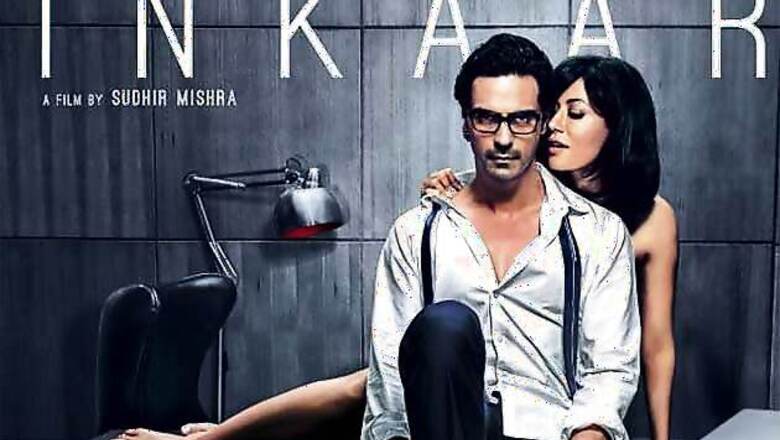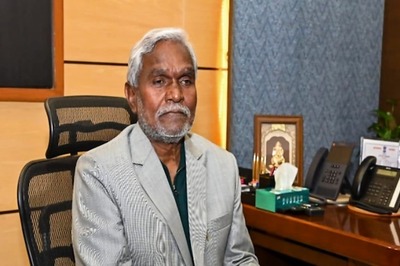
views
New Delhi: Has Bollywood really come of age? There are films which are pushing the boundaries and coming out of the realms of the usual potboilers. But you only have to scratch the surface to see how the bravest of filmmakers prefer to stick to stereotypes than venture out in the cinematic wilderness alone.
There are spoilers ahead so if you haven't seen 'Inkaar' yet, we would suggest you to come back to this write-up later.
Sudhir Mishra's latest offering 'Inkaar' is bold and dares to tackle an issue that is always hushed up - be it in films or in reality. But when you watch 'Inkaar' you realise that the film reminds you of Madhur Bandarkar's collection of work.
Interestingly, both Mishra and Bhandarkar showed amazing spark when they first made their foray into the film industry. Here were two young directors who wanted to expose the dark underbelly of the society through their films. While Mishra's 'Dharavi' narrated the story of a cab driver in Asia's largest slum, Bhandarkar narrated the story of the infamous bar dancers of Mumbai in 'Chandni Bar'.
Madhur went on to make films on certain industries. He took on the media in 'Page 3', the fashion industry in 'Fashion', the corporate world in 'Corporate' and the industry he belongs to - Bollywood - in 'Heroine'. While his earlier films revealed some startling truths about the society, over the years Bhandarkar started heavily relying on stereotypes. So much so that each of films were more or less based on the same framework and style.
Mishra, on the other hand, has stealthily risen as one of those filmmakers whose films made the viewer think. His 'Hazaaron Khwashein Aisi' remains a classic and the perfect example of the neo- leftist movement that exists in the country where the main protagonist (Kay Kay Menon) a staunch leftist, a student leader and the voice of the poor ultimately leaves everything to go and settle in capitalist America.
'Inkaar' somehow dilutes the main issue - that of sexual harassment at work - and ultimately becomes a love story. The much publicised sexual harassment fizzles out into a tame tale of jilted love and the promise of a reunion.
During the climax, Chitrangada Singh accuses Arjun Rampal of turning her into a 'slut' to save her job. And her realisation that the whole case has been blown out of proportion comes only after she almost sleeps with her American boss, just like the scene in 'Fashion' where Priyanka realises she has changed into a different person only after she has an drunken one night stand with an African.
Singh is okay having a one night stand with her mentor, having an affair with a colleague or falling in love with a man who is known for his philandering ways but heavily moralises the narration when her foreigner boss makes a pass at her - a trap that she herself created in the first place to prove her point and save her case.
The similarities between Bhandarkar's characters and the characters in 'Inkaar' are plenty. The lead protagonists make it big after coming to Mumbai from small towns. They also shun the glamorous lifestyle to go back to their roots in search of peace. They can be extremely ambitious, modern in their outlook but at the end of the day the morals and ethics will creep into their consciousness and make them the most boring, predictable people on earth.
The film talks about the weaker sex climbing the corporate ladder and how society cannot tolerate the rise. There are obstacles at every juncture and even if she cries hoarse about being exploited by a colleague (who also happens to be her ex boyfriend) her office management will side with the man. Because (and note the rolling of the eyes) she is a woman. And women are never taken seriously.
What plagues filmmakers today is the fact that even though they want to make realistic films, they have to keep in mind the commercial viability. And that is the biggest trap in front of a creative artiste.
So, the focus from the main plot is shifted and more emphasis is given to item numbers (the 'Halkat Jawani' number in 'Heroine') and insipid love stories.
And that is the same trap that 'Inkaar' falls into. Ambitions, revenge, the rush to rise to the top cloud a serious issue that needed to be dealt with seriously. It could have ended well if either party won the case, or they had settled it out of court. But no, the lead protagonists just disappear into oblivion in search of love.
Both Mishra and Bhandarkar's narrative also heavily rely on character artistes. But in spite of having trained, talented actors in cameos, they are merely used as props who remain caricatures.
So is the film really any different from the usual run of mill romances that Bollywood is famous for? Perhaps not. Both the directors are considered 'hatke' but ultimately cave in to the market demands. They want to tell a realistic tale but ultimately get entrapped in stereotypes. In the tussle between saleability and creativity, money seems to be the dominant factor. Inkaar could have been a Bhandarkar film, only it would have been called 'Agency'.
















Comments
0 comment